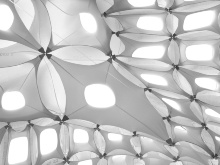Spatial Intensifiers
Deep Surface Membrane Climatic Fields Networks
Within classical membrane construction, defined primarily by its characteristic of low weight to maximum span, the geometrical possibilities have, arguably, been exhausted. The studio “Spatial Intensifiers” will examine the potential in expanding form and performance possibilities in membrane structures by integrating new technologies and techniques with integral structural logics (“Bending-Active” elements) and multi-dimensional materiality (“Deep Surface” systems). The concepts and processes will resource current research developments from both the ICD and ITKE, serving as strategies for the design and development of a deployable tension and bending-active building system.
The thinness of membrane materials, while providing for minimalistic design, proves unsatisfactory in performance for acoustic and thermal modulation. As a structure, significant secondary systems are often required to address the resolution of intense tension forces needed to hold the structure in place. These aspects are directly engaged through the use of “Deep Surface” membrane arrangements and integrated “Bending-Active” flexible elements. A “Deep Surface” utilizes multiple interconnected membrane layers and cells to expand the thickness of the structural surface while maintaining low weight. Such material arrangements can be instrumentalized to control and differentiate acoustic, thermal, and other atmospheric conditions. The calibration of these performances will be supported by the Institute for Building Physics. Elastic “Bending-Active” elements placed within and across these cells introduce and localize tension-forces proving a secondary anchoring system to be unnecessary. This structural strategy allows for an intensely light-weight structure and one which is very minimally connected to its surrounding environment.
The application of these strategies will be for the design of a light-weight deployable building system set in an isolated natural setting, with the approximate size of 100sqm. Within this context, the design shall be tuned to register differentiated and specific atmospheric intensities related to view, acoustics, and climate. Structurally, the design will be strategized for minimal invasiveness into the surrounding landscape. The design shall consider spatial arrangements which organize varying degrees of accommodation in scale and purpose, from large gathering to intimate research and reflection. The focus of the design studio will be clearly set upon the development of a spatial and material building design, not of just a prototypical material strategy.
Work will be developed in groups throughout the semester. The culmination will be a series of building designs. One of these designs will be selected for construction during the summer semester 2012. The work during the winter and following summer semester is sponsored by leading membrane and textile manufacturers. They will supply material and hardware for design development during the winter semester, and for construction during the summer semester.
The studio will be held in both English and German. Students participating in the studio must also take the Textile Architecture seminar by Julian Lienhard, where the foundations for membrane design and construction will be taught. Your final submission for the studio will serve also as the final submission for the seminar. Knowledge of Rhino Scripting, Processing and Grasshopper are recommended but not required.


